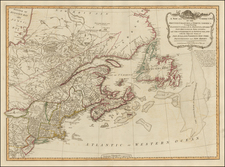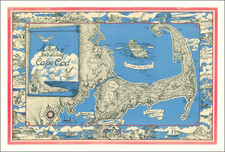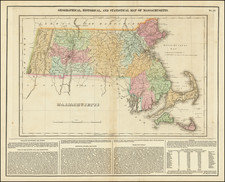The Earliest Map of the Town of Nantucket.
Inscribed by the Publisher to a Fellow Nantucketer.
Impressive early-19th-century wall map of the Town of Nantucket, capturing the village during the peak of the whaling period and preserving its layout prior to the devastating Great Fire of 1846.
The map shows the town in exacting and unprecedented detail and remains one of the best tools for understanding its pre-fire configuration. Individual buildings are demarcated, streets are labeled, and an index in the upper left provides further information about the town. This includes such minutiae as the building materials of each structure. A description of the island, with an interesting note regarding its geology, appears in the lower left.
The map was created from surveys by William Coffin, Jr., a scion of one of the most prominent Nantucket families whose relatives were deeply involved in the whaling trade. It was published by Henry Clapp in Nantucket (lithographed by Pendleton's in Boston), who was a notable early Nantucket publisher. This example of the map bears Clapp's presentation inscription to Maria T. Dibble.
Maria T. Dibble was an early member of the Nantucket Historical Association, and she appeared in the rolls of members as early as 1906 and remained there until at least 1918. At the time of the inscription, dated 1863, she was still married to her first husband, Orville Dibble, who died the following year. She was born (and would eventually re-marry) into the Swain family, a Quaker family who emigrated to Nantucket in 1658 and composed two of the nine original proprietors of the island. The Clapps and Swains were evidently close, as Henry Clapp appears in the Alfred Swain papers held by the Nantucket Historical Society as early as 1854.
William Coffin Jr. (1798-1838)
William Coffin Jr. was a member of the great Coffin clan, whose patriarch, Tristram Coffin, was one of the first proprietors of the island. By 1763, there were as many as six Coffins that were captains of Nantucket Whalers.
William Coffin Jr. was born of William Coffin (1756-1835), a prominent businessman who, despite being Quaker, ran against the prevailing gentler personalities of the island. However, William Coffin Jr. was regarded as "a kindler, gentler version of his father" (Phillbrick). He was a school teacher and newspaper editor who found favor with the island's other residents.
How Coffin learned the surveying trade is uncertain. The first record we find of the map is in an 1833 edition of the Inquirer and Mirror, entitled Proposals For a Map of the Town of Nantucket. It proposes a "map of the Town of Nantucket, embracing all the streets, lanes and alleys, together with the edifices, public and private, on the same." Coffin further notes in the proposal that, due to the "merely local interest" of the map and, it would be more expensive than comparable maps. The listed price for subscribers is $3 in sheets and $5 if "mounted with rollers, varnished, and otherwise furnished in the handsomest style," like the present example.
Henry Clapp (1784-1873)
Even less is known of Clapp's life than of Coffin's. His father is unknown, and he is only known to have a brother named Timothy. As early as the 1810s, he was publishing works in Nantucket, and we find records for his A Narrative of the Robbery of the Nantucket Bank (1816). He also appeared to be a bookseller, and he is listed in the publisher's list of The Nautical almanac, and astronomical ephemeris for the year 1821.
Clapp's son, Henry Clapp Jr., left a larger mark on the world, and is credited with importing the term Bohemian to New York. His alcoholism, and his general adoration of city life, likely drove him to leave the Nantucket that his father evidently enjoyed so much, and first headed to Paris and then to New York. Clapp Jr. established his place as an important figure in American history by publishing a literary magazine that kept Walt Whitman's writings in public view when the latter was less popular. Whitman ensured that his own biography could not be written without crediting the start that he received from Clapp Jr.
Primacy
We find no other maps of the Town of Nantucket listed in OCLC prior to 1834 when delimiting the search to "Nantucket" "1782-1834" and searching for maps. A similar search at the Leventhal Map Center and the Nantucket Historical Association reveals no further information. We are unaware of maps in atlases or pilots pre-dating 1834 that focus on the town. General searches reveal no predecessor.
Rarity
We find only a single record of the map in OCLC, at the NYPL. We are also aware of a holding at the Nantucket Historical Association (which also holds two manuscripts of the map, dated 1833). In addition, we find a reference to an example in the National Archives, although we were unable to substantiate this.










![[ Revolutionary War Boston ] Carte Particuliere Du Havre De Boston . . . 1780](https://storage.googleapis.com/raremaps/img/small/61227.jpg)
![[ Temperance Allegorical View ] Black Valley Railroad. Tickets Sold at all Liquor Shops. Accidents by Collisions are Entirely Avoided, as no up Trains are Run Over the Road.](https://storage.googleapis.com/raremaps/img/small/101469.jpg)


